...to the point from which one started.
Any good bummel is, as Jerome K. Jerome wrote,
 I am now safely back, if a bit damp, in Lincoln Square. But there are a few loose ends. First, an insatiable curiosity drove me through the west- and southside neighborhoods. I rolled along in search of unique sensations and reflections. Why? Simply put, Chicago is a crucible of fascinating ideas and I hope this brief bummel has at least introduced them to you.
I am now safely back, if a bit damp, in Lincoln Square. But there are a few loose ends. First, an insatiable curiosity drove me through the west- and southside neighborhoods. I rolled along in search of unique sensations and reflections. Why? Simply put, Chicago is a crucible of fascinating ideas and I hope this brief bummel has at least introduced them to you.
 Before returning I rolled out of Humboldt Park on my way to the final two neighborhoods. For me, West Town is THE bike neighborhood in Chicago. It's home to the city's only bikers watering-hole: The Handle Bar. The first Wednesday of every month, it offers free quesadias for members of the Chicagoland Bike Federation.
Before returning I rolled out of Humboldt Park on my way to the final two neighborhoods. For me, West Town is THE bike neighborhood in Chicago. It's home to the city's only bikers watering-hole: The Handle Bar. The first Wednesday of every month, it offers free quesadias for members of the Chicagoland Bike Federation.
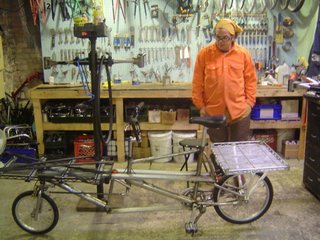 It's also home to West Town Bikes, a non-profit community learning space committed to teaching bicycle maintenance and repair in the neighborhood. Alex Wilson, who founded and manages West Town Bikes, started a very cool youth program, BikerBikes. They build their own specialty bikes using novel utilitarian human powered design while getting training in safe biking practices. The New Communities Program of the Local Initiatives Support Corporation, recently showcased the program with a rather engaging video.
It's also home to West Town Bikes, a non-profit community learning space committed to teaching bicycle maintenance and repair in the neighborhood. Alex Wilson, who founded and manages West Town Bikes, started a very cool youth program, BikerBikes. They build their own specialty bikes using novel utilitarian human powered design while getting training in safe biking practices. The New Communities Program of the Local Initiatives Support Corporation, recently showcased the program with a rather engaging video.
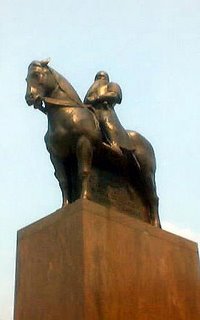 The last neighborhood on my bummel was Hyde Park. Home to the University of Chicago, it's known as THE intellectual enclave of the southside, if not the whole city. There are a number of good museums and lots of fascinating historical sights like the Blanik Mountain Knight. The statue honors Tomas Masaryk, the Chech fighter, author, and diplomat who became Czecheslovakia's first president. He taught briefly at the University of Chicago in 1902 and 1908.
The last neighborhood on my bummel was Hyde Park. Home to the University of Chicago, it's known as THE intellectual enclave of the southside, if not the whole city. There are a number of good museums and lots of fascinating historical sights like the Blanik Mountain Knight. The statue honors Tomas Masaryk, the Chech fighter, author, and diplomat who became Czecheslovakia's first president. He taught briefly at the University of Chicago in 1902 and 1908.
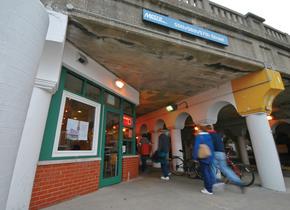 I set up camp at the Istria Cafe underneath the Metra tracks. There I tied up a final loose end concerning the Situationists influence on Critical Mass. Despite academic arguments to the contrary, I believe that the call for revolutionizing everyday life explains both the nature and longevity of the mass at in two ways.
I set up camp at the Istria Cafe underneath the Metra tracks. There I tied up a final loose end concerning the Situationists influence on Critical Mass. Despite academic arguments to the contrary, I believe that the call for revolutionizing everyday life explains both the nature and longevity of the mass at in two ways.
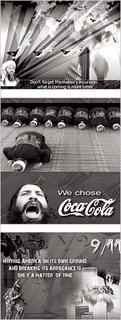 On the one hand, the Situationists critique of 1960s Western society is widespread throughout the American anti-globalization movement today. Beyond the US, this critique has spread to many non-Western societies including those in the Islamic World. For example, Monday's commemorations of 9.11 included jihadi websites that bluntly criticize US cultural and economic domination of the world. The sites also unambigously promote extreme violence by inciting a righteous hatred against all non-Muslims. Unquestionably, this reveals the profundly dark side of the Situationists. Unfortunately, it obscures the lighter side as well.
On the one hand, the Situationists critique of 1960s Western society is widespread throughout the American anti-globalization movement today. Beyond the US, this critique has spread to many non-Western societies including those in the Islamic World. For example, Monday's commemorations of 9.11 included jihadi websites that bluntly criticize US cultural and economic domination of the world. The sites also unambigously promote extreme violence by inciting a righteous hatred against all non-Muslims. Unquestionably, this reveals the profundly dark side of the Situationists. Unfortunately, it obscures the lighter side as well.
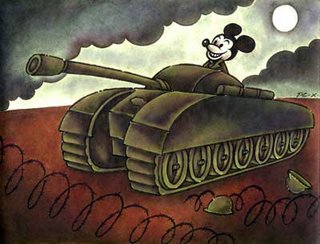 And on the other hand? It is this lighter side which specifically influences Critical Mass in a very positive way. Like the bummel before it, the mass shares a close family resemblance to the dérives. The Situationists made spontaneous trips around Paris and other French cities with no purpose other than to absorb and enjoy the urban environment. These were an adult Easter Egg Hunt of sorts, filled with treasures to discover for those with the perspective and the concentration to see what nature had concealed. Chaotic and unguided, the dérives would create free and open spaces for revitalizing individuals and ultimately whole communities.
And on the other hand? It is this lighter side which specifically influences Critical Mass in a very positive way. Like the bummel before it, the mass shares a close family resemblance to the dérives. The Situationists made spontaneous trips around Paris and other French cities with no purpose other than to absorb and enjoy the urban environment. These were an adult Easter Egg Hunt of sorts, filled with treasures to discover for those with the perspective and the concentration to see what nature had concealed. Chaotic and unguided, the dérives would create free and open spaces for revitalizing individuals and ultimately whole communities.
 Raoul Vaneigem, who laid the theoretical foundations for the New Urbanism now sweeping the US, described dérives as carnivals in which the individual life celebrates its unification with a regenerated society. What could be more like a chaotic, unguided carnival than Critical Mass?
Raoul Vaneigem, who laid the theoretical foundations for the New Urbanism now sweeping the US, described dérives as carnivals in which the individual life celebrates its unification with a regenerated society. What could be more like a chaotic, unguided carnival than Critical Mass?
 As I posted yesterday, Guy Debord anticipated its acute antipathy of cager culture with his nine Situationists Theses on Traffic:
As I posted yesterday, Guy Debord anticipated its acute antipathy of cager culture with his nine Situationists Theses on Traffic: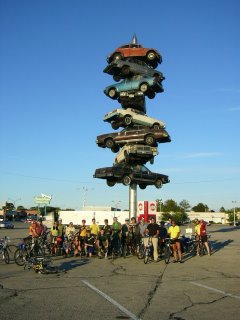 Obviously not all massers think of cagers in these terms. Many own cars. Nor do all see themselves advocates for an meaningful non-materialist alternative to the rampant consumerism of western society. Nevertheless, I think that all massers ride to be a part of the carnival; something bigger than themselves that was first glimpsed by the Situationists on the streets of Paris.
Obviously not all massers think of cagers in these terms. Many own cars. Nor do all see themselves advocates for an meaningful non-materialist alternative to the rampant consumerism of western society. Nevertheless, I think that all massers ride to be a part of the carnival; something bigger than themselves that was first glimpsed by the Situationists on the streets of Paris.
And you don't need to know how to make a bike into a record player %)
without an end; the only thing regulating it being the necessity of getting back within a given time to the point from which one started.
 I am now safely back, if a bit damp, in Lincoln Square. But there are a few loose ends. First, an insatiable curiosity drove me through the west- and southside neighborhoods. I rolled along in search of unique sensations and reflections. Why? Simply put, Chicago is a crucible of fascinating ideas and I hope this brief bummel has at least introduced them to you.
I am now safely back, if a bit damp, in Lincoln Square. But there are a few loose ends. First, an insatiable curiosity drove me through the west- and southside neighborhoods. I rolled along in search of unique sensations and reflections. Why? Simply put, Chicago is a crucible of fascinating ideas and I hope this brief bummel has at least introduced them to you. Before returning I rolled out of Humboldt Park on my way to the final two neighborhoods. For me, West Town is THE bike neighborhood in Chicago. It's home to the city's only bikers watering-hole: The Handle Bar. The first Wednesday of every month, it offers free quesadias for members of the Chicagoland Bike Federation.
Before returning I rolled out of Humboldt Park on my way to the final two neighborhoods. For me, West Town is THE bike neighborhood in Chicago. It's home to the city's only bikers watering-hole: The Handle Bar. The first Wednesday of every month, it offers free quesadias for members of the Chicagoland Bike Federation. It's also home to West Town Bikes, a non-profit community learning space committed to teaching bicycle maintenance and repair in the neighborhood. Alex Wilson, who founded and manages West Town Bikes, started a very cool youth program, BikerBikes. They build their own specialty bikes using novel utilitarian human powered design while getting training in safe biking practices. The New Communities Program of the Local Initiatives Support Corporation, recently showcased the program with a rather engaging video.
It's also home to West Town Bikes, a non-profit community learning space committed to teaching bicycle maintenance and repair in the neighborhood. Alex Wilson, who founded and manages West Town Bikes, started a very cool youth program, BikerBikes. They build their own specialty bikes using novel utilitarian human powered design while getting training in safe biking practices. The New Communities Program of the Local Initiatives Support Corporation, recently showcased the program with a rather engaging video. The last neighborhood on my bummel was Hyde Park. Home to the University of Chicago, it's known as THE intellectual enclave of the southside, if not the whole city. There are a number of good museums and lots of fascinating historical sights like the Blanik Mountain Knight. The statue honors Tomas Masaryk, the Chech fighter, author, and diplomat who became Czecheslovakia's first president. He taught briefly at the University of Chicago in 1902 and 1908.
The last neighborhood on my bummel was Hyde Park. Home to the University of Chicago, it's known as THE intellectual enclave of the southside, if not the whole city. There are a number of good museums and lots of fascinating historical sights like the Blanik Mountain Knight. The statue honors Tomas Masaryk, the Chech fighter, author, and diplomat who became Czecheslovakia's first president. He taught briefly at the University of Chicago in 1902 and 1908. I set up camp at the Istria Cafe underneath the Metra tracks. There I tied up a final loose end concerning the Situationists influence on Critical Mass. Despite academic arguments to the contrary, I believe that the call for revolutionizing everyday life explains both the nature and longevity of the mass at in two ways.
I set up camp at the Istria Cafe underneath the Metra tracks. There I tied up a final loose end concerning the Situationists influence on Critical Mass. Despite academic arguments to the contrary, I believe that the call for revolutionizing everyday life explains both the nature and longevity of the mass at in two ways. On the one hand, the Situationists critique of 1960s Western society is widespread throughout the American anti-globalization movement today. Beyond the US, this critique has spread to many non-Western societies including those in the Islamic World. For example, Monday's commemorations of 9.11 included jihadi websites that bluntly criticize US cultural and economic domination of the world. The sites also unambigously promote extreme violence by inciting a righteous hatred against all non-Muslims. Unquestionably, this reveals the profundly dark side of the Situationists. Unfortunately, it obscures the lighter side as well.
On the one hand, the Situationists critique of 1960s Western society is widespread throughout the American anti-globalization movement today. Beyond the US, this critique has spread to many non-Western societies including those in the Islamic World. For example, Monday's commemorations of 9.11 included jihadi websites that bluntly criticize US cultural and economic domination of the world. The sites also unambigously promote extreme violence by inciting a righteous hatred against all non-Muslims. Unquestionably, this reveals the profundly dark side of the Situationists. Unfortunately, it obscures the lighter side as well. And on the other hand? It is this lighter side which specifically influences Critical Mass in a very positive way. Like the bummel before it, the mass shares a close family resemblance to the dérives. The Situationists made spontaneous trips around Paris and other French cities with no purpose other than to absorb and enjoy the urban environment. These were an adult Easter Egg Hunt of sorts, filled with treasures to discover for those with the perspective and the concentration to see what nature had concealed. Chaotic and unguided, the dérives would create free and open spaces for revitalizing individuals and ultimately whole communities.
And on the other hand? It is this lighter side which specifically influences Critical Mass in a very positive way. Like the bummel before it, the mass shares a close family resemblance to the dérives. The Situationists made spontaneous trips around Paris and other French cities with no purpose other than to absorb and enjoy the urban environment. These were an adult Easter Egg Hunt of sorts, filled with treasures to discover for those with the perspective and the concentration to see what nature had concealed. Chaotic and unguided, the dérives would create free and open spaces for revitalizing individuals and ultimately whole communities. Raoul Vaneigem, who laid the theoretical foundations for the New Urbanism now sweeping the US, described dérives as carnivals in which the individual life celebrates its unification with a regenerated society. What could be more like a chaotic, unguided carnival than Critical Mass?
Raoul Vaneigem, who laid the theoretical foundations for the New Urbanism now sweeping the US, described dérives as carnivals in which the individual life celebrates its unification with a regenerated society. What could be more like a chaotic, unguided carnival than Critical Mass? As I posted yesterday, Guy Debord anticipated its acute antipathy of cager culture with his nine Situationists Theses on Traffic:
As I posted yesterday, Guy Debord anticipated its acute antipathy of cager culture with his nine Situationists Theses on Traffic:A mistake made by all the city planners is to consider the private automobile (and its by-products, such as the motorcycle) as essentially a means of transportation. In reality, it is the most notable material symbol of the notion of happiness that developed capitalism tends to spread throughout the society. The automobile is at the center of this general propaganda, both as supreme good of an alienated life and as essential product of the capitalist market[.]
 Obviously not all massers think of cagers in these terms. Many own cars. Nor do all see themselves advocates for an meaningful non-materialist alternative to the rampant consumerism of western society. Nevertheless, I think that all massers ride to be a part of the carnival; something bigger than themselves that was first glimpsed by the Situationists on the streets of Paris.
Obviously not all massers think of cagers in these terms. Many own cars. Nor do all see themselves advocates for an meaningful non-materialist alternative to the rampant consumerism of western society. Nevertheless, I think that all massers ride to be a part of the carnival; something bigger than themselves that was first glimpsed by the Situationists on the streets of Paris.And you don't need to know how to make a bike into a record player %)
Labels: cagers, Chicago, history, Lincoln Square, Situationists

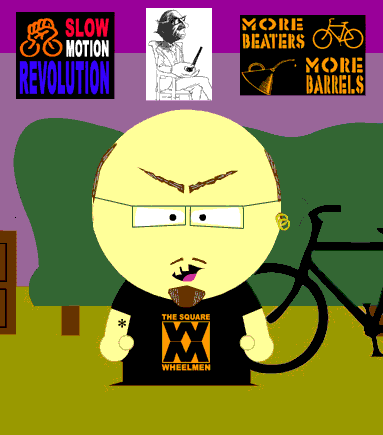





0 Comments:
Post a Comment
<< Home